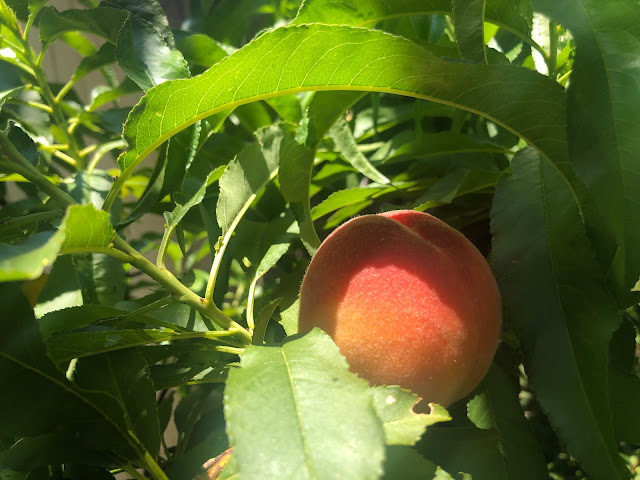
Summer gets off to blazing start with string of 100-plus days

|
| Harvest ripening peaches, along with apricots and plums. Hot weather is expected this next week as summer arrives. (Photo: Kathy Morrison) |
Get ready for a red-hot summer! Tuesday is officially the first day of summer – and what could be the start of a string of triple-digit days.
According to the National Weather Service, Sacramento can expect to see afternoon highs of 100 to 103 degrees Tuesday through Friday before a slight dip back into the high 90s next weekend. The forecast is relentlessly sunny and dry. Normal for mid June in Sacramento: high of 87 and low of 56.
Overnight lows also will be about 10 degrees higher than normal, hovering in the mid 60s. That makes for warm mornings, too. Irrigate before 8 a.m. to avoid quick evaporation. That’s the best time for exercise and any outdoor chores, too.
This warm spell has benefits. Say goodbye to powdery mildew! Infected leaves will fall off and (fingers crossed) soon be replaced with healthy foliage. Make sure to pick up and dispose of that mildewed foliage; otherwise, it can reinfect healthy leaves in the fall.
Hot days also prompt rapid growth of such summer favorites as tomatoes, squash and peppers. Inspect plants daily if possible. Watch for evidence of spider mites, leaf-footed bugs and tomato hornworms, and act quickly if you find them.
* Keep vegetables irrigated with even moisture in the root zone. That will help those fast-growing plants cope with high heat as well as prevent blossom end rot.
* Are plants getting enough water? Check soil with a moisture meter or feel for yourself – take a trowel and dig down 6 inches. If the soil will ball in your hand, it’s moist. If it’s powdery or (worse) if you can’t dig down 6 inches, it’s time for a deep soak.
* Mulch, mulch, mulch! This “blanket” keeps moisture in the soil longer and helps your plants cope during hot weather. Use organic material (premade mulch, wood chips, leaves, straw), but not rocks -- rocks absorb heat and will stress the plants.
* Water your lawn during the wee hours of the morning, between 2 and 8 a.m.
* If you haven’t already, upgrade lawn irrigation with rotator heads; this simple switch waters better (deeper, more complete coverage, less runoff) while saving water. Rebates are available, www.bewatersmart.info .
* Don’t fertilize during triple-digit heat. It can stress plants. Wait until another cooldown.
* Avoid pot “hot feet.” Place a 1-inch-thick board under container plants sitting on pavement. This little cushion helps insulate them from radiated heat.
* Tie up vines and stake tall plants such as gladiolus and lilies. That gives their heavy flowers some support.
* Dig and divide crowded bulbs after the tops have died down.
* Thin grapes on the vine for bigger, better clusters later this summer.
* Cut back fruit-bearing canes on berries after harvest.
* Cut back Shasta daisies after flowering to encourage a second bloom in the fall.
* Trim off dead flowers from rose bushes to keep them blooming through the summer.
* Pinch back chrysanthemums for bushier plants with many more flowers in September.
* Harvest onions and garlic.
* Harvest fruit; apricots, plums and peaches are ripening quickly. Pick up fallen fruit to dissuade pests.
* From seed or transplant, plant basil, corn, melons, bush beans, pumpkins, radishes, squash and sunflowers.
* Transplant summer annuals such as petunias, marigolds, cosmos and zinnias.
* Transplant perennial flowers including astilbe, columbine, coneflowers, coreopsis, dahlias, rudbeckia, salvia and verbena.
Comments
0 comments have been posted.Sacramento Digs Gardening to your inbox.
Sites We Like
Garden Checklist for week of July 21
Your garden needs you!
* Keep your vegetable garden watered, mulched and weeded. Water before 8 a.m. to reduce the chance of fungal infection and to conserve moisture.
* Feed vegetable plants bone meal, rock phosphate or other fertilizers high in phosphate to stimulate more blooms and fruiting. (But wait until daily high temperatures drop out of the 100s.)
* Don’t let tomatoes wilt or dry out completely. Give tomatoes a deep watering two to three times a week.
* Harvest vegetables promptly to encourage plants to produce more. Squash especially tends to grow rapidly in hot weather. Keep an eye on zucchini.
* Pinch back chrysanthemums for bushy plants and more flowers in September.
* Remove spent flowers from roses, daylilies and other bloomers as they finish flowering.
* Pinch off blooms from basil so the plant will grow more leaves.
* Cut back lavender after flowering to promote a second bloom.
* It's not too late to add a splash of color. Plant petunias, snapdragons, zinnias and marigolds.
* From seed, plant corn, pumpkins, radishes, winter squash and sunflowers.